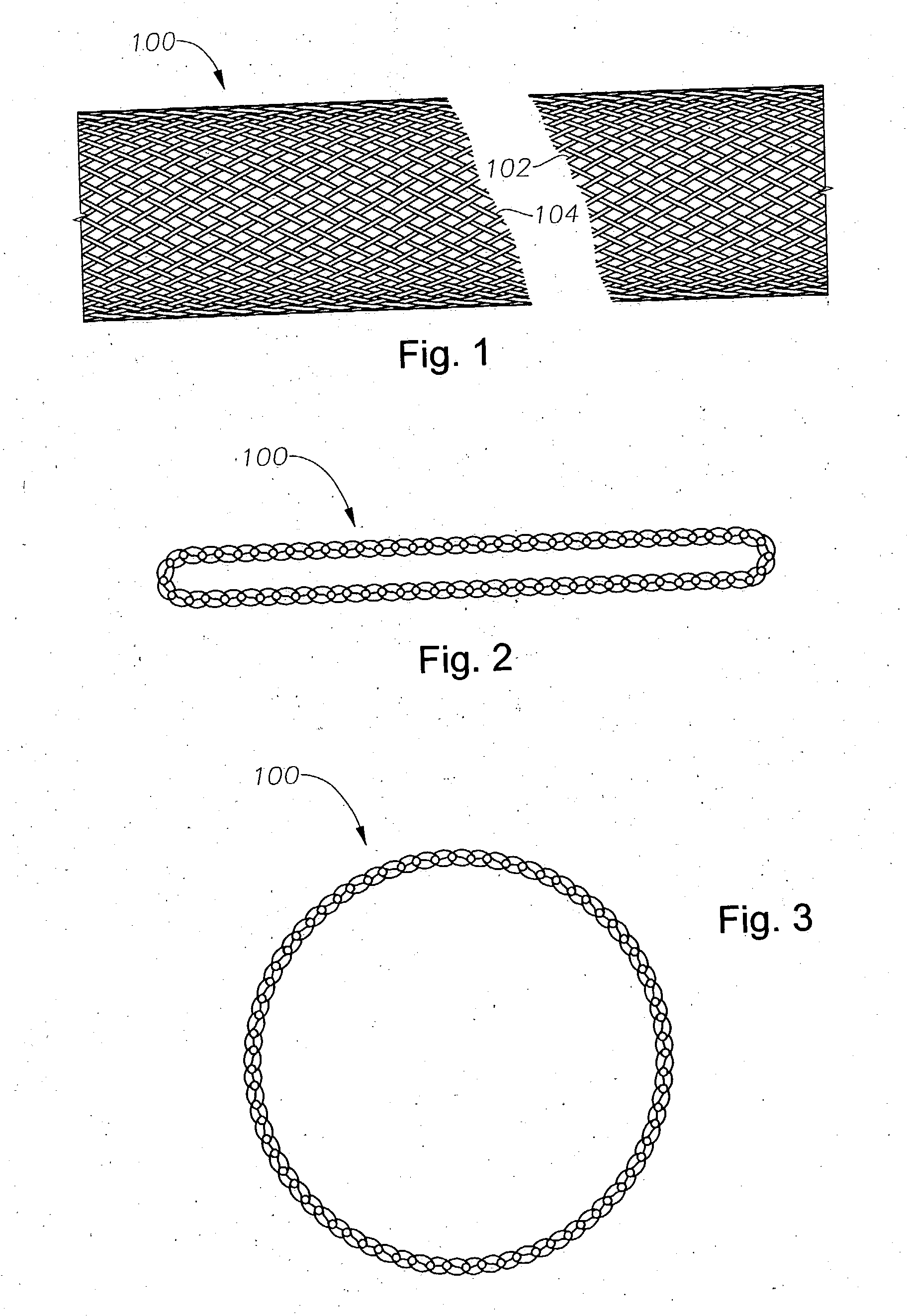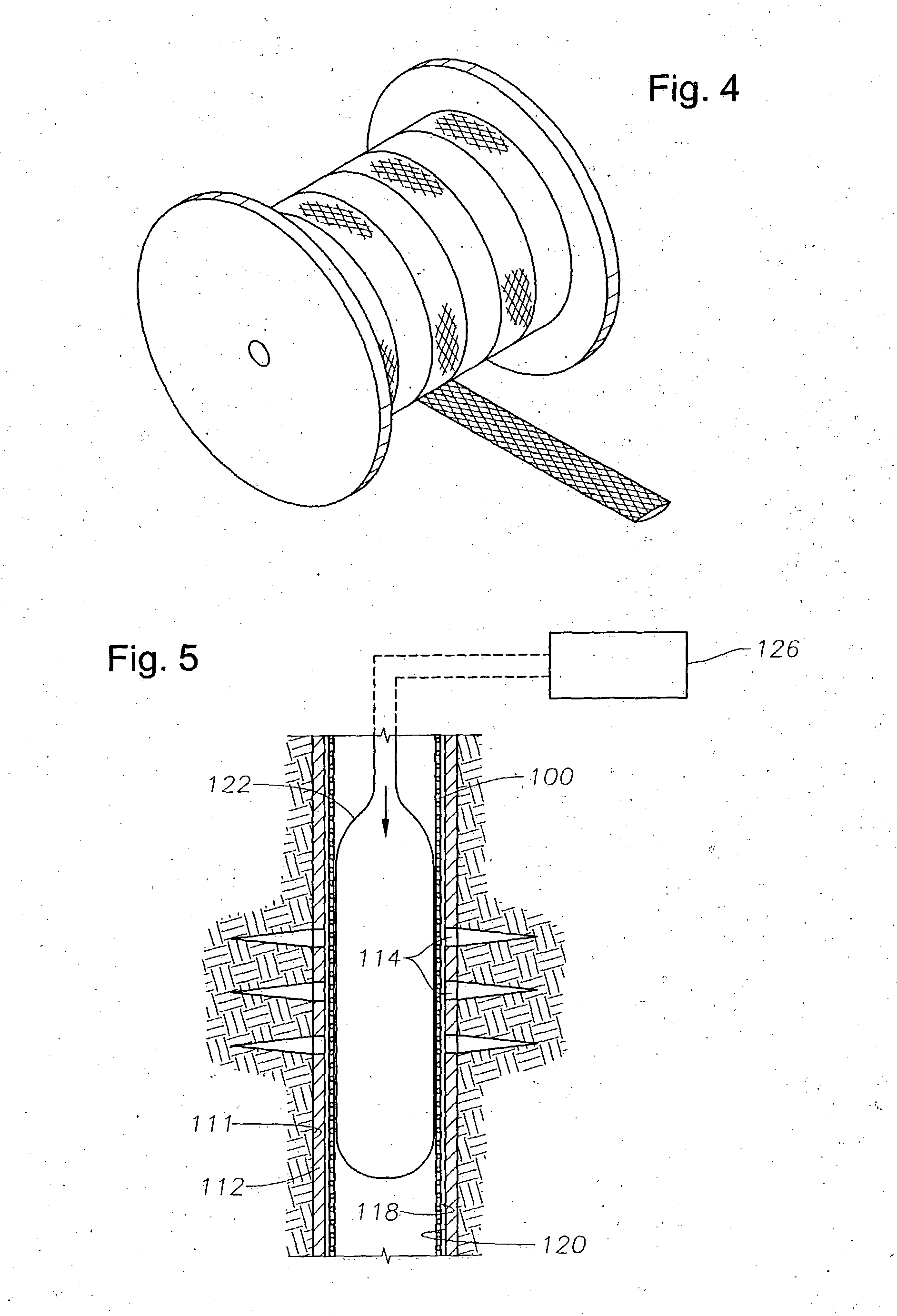[0028] In still another embodiment, implementations of the invention may include applications external to metallic casing or sand screens. In one such application, shown in FIG. 7, the casing comprises a metallic expandable tubular 146, used in well construction for reducing or eliminating
diameter transitions, such as in a monobore well. In this application, the sleeve may be run into the well prior to placement of the metallic casing or can be inserted into the well on the outer
diameter of the metallic casing. In order to maintain a continuous sleeve, a longitudinal or
helical seam may be required that is either stitched or adhered together during installation. The tubular braided sleeve 148 expands as the casing or screen is expanded by the drawing of a mandrel 142 which is pulled toward the surface using a cable or
wireline 144. This configuration is particularly useful in combination with embedded metallic conductors or
optical fiber for use in conductors because of the difficulty in providing for
signal and data communication in monobore or reduced diameter transition wells. Because the structural support provided by the tubular braided sleeve may reduce the forces and stresses on the metallic expandable casing, one
advantage of the present invention is to reduce the weight and thickness requirement for the metallic expandable casing or screen thereby decreasing the forces and pressure required to expand the metallic expandable casing or screen as well as the time required to accomplish that expansion. These factors may also allow for a larger diameter change during expansion of the metallic expandable casing g or screen. The heat required for curing can be provided by circulating high temperature fluids within the bore of the tubular, by electrical resistance heating of conductors embedded in the composite
braid, by an
exothermic reaction of casing
cement in the vicinity of the sleeve, or by any other practical means.
[0029] In another embodiment of the invention, for use as
production tubing or casing in deep wells, an internal cable (not shown) is placed within the tubular
braid in order to support the tension loading during installation. The internal cable may be metallic,
high performance polymer, or other material capable of bearing high longitudinal tensile stress. The internal cable is preferably incorporated into the
braid to distribute the load due to the weight of the sleeve to the cable and may optionally also support the weight of a device at the bottom of the sleeve, such as a
bottom hole assembly. Similarly, a longitudinal cable may be utilized to support the tubular braided sleeve during installation. Such a cable may be external or internal to the sleeve and may be removed after installation and curing of the resin.
[0030] Another use for the present invention is as a means for installing and fixing in place a composite screen for the purposes of particulate control, more specifically for confining sand to the formation while allowing the production fluid to flow out of the formation into the well bore. Current sand screens are manufactured as multiple
layers of
corrosion resistant steel
expanded metal and wire screens. A composite braided sleeve, or multiple braided sleeves, can be employed as a sand screen. A tubular braided sleeve can also be used as a protective shroud or layer over conventional metallic screens. The composite braided tubular sleeve could also incorporate metallic and / or
fiber optic conductors and / or sensors into the fabric to make a smart sand screen.
[0031] The braiding configuration can be easily optimized for the necessary mesh size as required to minimize
particulate flow into the well bore. It may also be possible to provide an adjustable mesh size by axially compressing or expanding the mesh to change the mesh size to allow for screen cleaning by backflushing the screen. The braided sleeve impregnated with a resin can be used as a means for providing a composite screen that can be inflated either mechanically or hydraulically (using a bladder inside to expand). Once the sleeve is in contact with the formation face and allowed to set, it would act as a sand control device that conforms to the well bore.
[0032] During drilling operations, a patch of braided sleeve can be used to cover a water-producing zone or a low fracture gradient zone or can be placed within a horizontal well bore to stabilize the well bore against collapse. The braided sleeve can be placed around the
drill string and expanded at the pre-specified location.
[0033] In yet another embodiment, the previously described tubular, braided sleeve may be easily installed in a well bore using systems that include a carrier (or sub) configured to hold the sleeve. FIG. 8 depicts such a
system being used to place a braided sleeve 214 in a well bore 210. The sleeve 214 is disposed within an interior of a carrier 212, which surrounds the length of sleeve 214. Further, an upper end of carrier 212 is attached to a lower end of a conveyance string 216, e.g., a drillpipe or tubing, for lowering carrier 212 into well bore 210. Alternatively, carrier 212 may be attached to other types of conveyance strings, e.g., a
wireline, to lower it downhole. In addition, an anchor 218 may be detachably attached with, e.g., shear pins, to the base of sleeve 214 for securing the sleeve to the bottom of well bore 210. Alternatively, extending arms attached to the base of sleeve 214 can be utilized to anchor sleeve 214 to the formation wall (not shown). The extending arms are similar to those currently used on
caliber tools. The extending arms may be maneuvered to drive the anchors into the sidewall of the formation, allowing sleeve 214 to be positioned mid-way in well bore 210. Although not shown, the
system may also include an
inflatable member inside of sleeve 214 for expanding a diameter of sleeve 214 when desired.
 Login to View More
Login to View More  Login to View More
Login to View More 


